Executive Summary
In last year’s Annual Report I set out my priorities for 2012-13. I report on all of these in this Report: firstly, to seek improved treatment and conditions for female offenders; secondly, to facilitate the introduction of Prisoner Visitor Centres and thereby improve family contact; thirdly, to seek improved prisoner access to Purposeful Activity; and fourthly, to encourage better preparation for release for prisoners.
During my appointment as Scotland’s Chief Inspector of Prisons I have formally inspected all prisons (some more than once; Cornton Vale three times) except for Edinburgh (to be inspected September 2013), Inverness (to be inspected February 2014), Aberdeen and Greenock. I have also carried out a number of thematic and other inspections6. I have visited all prisons regularly.
My four-year journey has been very much more than I was expecting. My reference at the start of my work was the report by the Prisons Commission (2008)and this has been a guide for me throughout. More than anything I have learned that it is a privilege to be Chief Inspector of Prisons. Very few other people have the access to prisoners, young offenders, prison staff and Third Sector organisations that I have had. It is a very moving experience to hear of a prisoner’s life, of their family, of their growing up experiences,of their school life and to realise why they have made wrong choices. It can be very much more moving to hear the same story from the family point of view, of the struggle to get to prison for a visit using public transport, of the vacuum in a child’s life without a father or mother. It is also important to see this from the victim’s or victim’s families’ position, of the pain caused by the offender.
Equally, I have greatly valued the connections I have made with Scotland’s Third Sector and other independent organisations whose commitment to improving the lot of vulnerable people continues to be outstanding. I have understood the issues so much more clearly due to the exceptionally helpful connections I have made with organisations, who, despite facing financial difficulties, have continued to deliver essential outcomes to so many vulnerable people. I have been inspired by them all.
All of this has given me a balanced and more comprehensive picture not only of Scotland’s criminal justice system but also of how prisoners are treated.
The realisation that the risks of offending are very much higher in certain postcodes leads to the conclusion that reducing reoffending needs to be focused on such areas if the cycle of reoffending is to be stopped. Perhaps a theme of the past four years has been the significant change that those of us involved in the criminal justice system have witnessed and been part of in order to stop this cycle. There has been a heartening drive not to accept the status quo but to find better ways and means to achieve more satisfactory outcomes.
ISBN 978 1 78256 583 3
DPPAS 14284
This document is also available in pdf format (856KB)
Contents
Chapter 2 Summary of Inspections Undertaken
Chapter 3 Review of the Prison Inspectorate's Year 2012-13
1. OVERVIEW

HM Chief Inspector of Prisons for Scotland
Brigadier Hugh Monro CBE
Introduction
My fourth and final Annual Report covers inspection year 2012-13 and also gives me an opportunity to provide a summary and some conclusions about the issues I have been concerned with during my time as Her Majesty's Chief Inspector of Prisons for Scotland (HMCIPS).
During the year I have inspected four very different prisons; the Open Estate at Castle Huntly, Addiewell, Polmont and Shotts and summaries of these reports are at Chapter 2 to this report. Access to all Inspectorate reports and other information is available on our website: www.scotland.gov.uk/hmip. In addition I have given evidence to the Scottish Parliament Justice Committee[1].
Inspection Year 2012-13
In last year's Annual Report I set out my priorities for 2012-13. I report on all of these in this Report:
- Firstly, to seek improved treatment and conditions for female offenders.
- Secondly, to facilitate the introduction of Prisoner Visitor Centres and thereby improve family contact.
- Thirdly, to seek improved prisoner access to Purposeful Activity.
- Fourthly, to encourage better preparation for release for prisoners.
HMP Open Estate
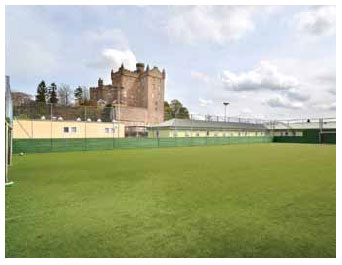
HMP Open Estate
My report on the Open Estate[2] assessed that the closure of HMP Noranside and the reorganisation of the Open Estate in to one site at Castle Huntly had gone well. However, I was concerned that, except for work placements within the community, other purposeful activity within the prison grounds was relatively limited. My expectation is that this situation will improve and will be re-inspected. I also hope that there will be a more positive determination to emphasise improved preparation for release. The inspection of the Open Estate demonstrated that education at Castle Huntly should be focusing on employability training for prisoners who should be preparing themselves for employment, rather than on literacy and numeracy which is emphasised in the current contract between the Scottish Prison Service (SPS) and the delivering colleges.
HMP Addiewell
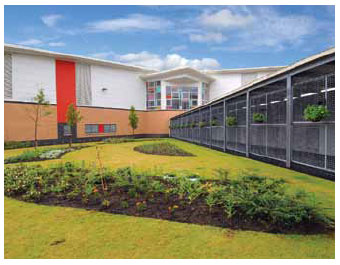
HMP Addiewell
I carried out an unannounced follow-up inspection of Addiewell[3] to see what progress this new, privately run prison had made since the first formal inspection there in 2011. I assessed that 'the prison is making good progress'. I was particularly pleased to see the significant improvement in participation in purposeful activity from about 60% to 75%. I said in the inspection report: "Much of the good work has been due to the ability of senior managers to interrogate the data produced from the Custodial Management System (CMS). The CMS is proving to be a useful prisoner management information tool. The related Kiosk system allows prisoners to book visits, select meal choices, access their own financial accounts, order items from the prison canteen and interrogate their own timetable. I suggest the SPS look at the opportunities that computerised management systems bring in terms of organising activities as well as other aspects of prisoner management."
I remain concerned about staff retention at Addiewell which meant that "some staff in halls appear to be inexperienced and are not as engaged with prisoners as I would have expected." I have been assured that increased staff salaries are beginning to improve this situation, but this will inevitably take some time to achieve.
HMYOI Polmont
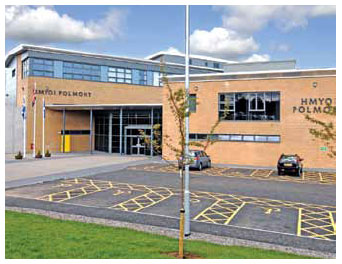
HMYOI Polmont
I inspected HMYOI Polmont[4] in October keen to see how well the concept of partnership working with organisations such as Barnardo's was working, particularly in respect of under 18 young offenders. In many respects Polmont is modern, well equipped and has good staff. However, I felt that the establishment "has not reached its potential either as a Young Offenders Institution or as a major part of the Reducing Reoffending Programme Phase 2 (RRP2)." I went on to say that "In Blair House (for young offenders aged under 18) there was little evidence of throughcare working with partners either as under 18s entered HMYOI Polmont or indeed to ensure better opportunities for success on release. Improved partnership working is critical if RRP2 is to succeed."
Polmont is 'the last chance to re-shape young lives, the final opportunity to enter society in a positive way and move away from the risks of reoffending …' I have recommended that a thorough review of management practices needs to be carried out in order to rectify the way the establishment is run and to provide significantly improved outcomes.
HMP Shotts

'Old' HMP Shotts demolished
HMP Shotts[5] has been completely re-built on a new site adjacent to the 'old' prison now demolished. Shotts caters for long-term prisoners, nearly half of whom are serving life sentences. This is a completely different prison where 'preparation for release' requires a significantly different approach to those where the majority of prisoners are serving shorter sentences. I was pleased to see, therefore, that there were good staff/prisoner relationships and that this makes for a stable and safe prison.
However, I was disappointed not to see the sort of computerised management technology that is available at Addiewell and which would have made the management of prisoners at Shotts more effective and efficient. Nevertheless, I am told, that with sufficient resourcing, both Shotts and the newly-built Low Moss can be 'retro-fitted' with such technology in due course and I encourage the SPS Board to consider this course of action.
General
During the year I have been able to assess how well the transfer of healthcare in prisons from the SPS to the NHS has progressed. The evidence that I have seen suggests that prisoners are now getting a level of healthcare in prison comparable to that in the community and that is what I would expect to see. At this stage, the transition has gone well and the Inspectorate will continue to monitor the situation.
I do have a concern that Governors-in-Charge have lost a degree of control over the standard of healthcare provided in their prisons. This does not matter if relations and working practices between the prison and the local NHS Board work well. In most cases this is what I see. But what happens if the Governor feels the healthcare service is not sufficiently good and this view is not supported by the local NHS Board? It is important that the Chief Inspector continues to use Healthcare Improvement Scotland (HIS) inspectors to scrutinise such situations and to report accordingly in order that healthcare is provided to appropriate standards in prisons.
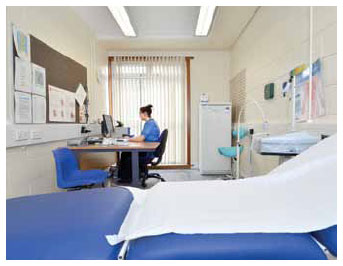
Healthcare post NHS integration HMP Open Estate
What progress has been made in respect of my priorities for the year? I am pleased to say that progress has been made on improved treatment and conditions for female prisoners. I now no longer consider Cornton Vale to be 'in crisis'. Conditions there are very much better as I describe later in this report. Female Offenders at HMP Edinburgh and at Greenock are well treated.
In respect of improved family contact I am more optimistic about the introduction of Prisoner Visitor Centres than I was previously, not least because SPS Headquarters now supports the principle of these centres. This change is discussed in the Family Access section of the report.
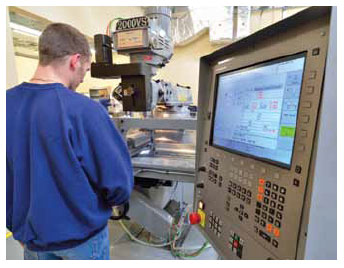
HMP Shotts - production workshed
However, in terms of seeking improved purposeful activity I am less optimistic. There are three aspects to this. First is the need to get many more prisoners out of their cells to purposeful activities. Second is the increasingly important and pressing need to improve the quality of the activities themselves. I see too many prisoners supposedly engaged in work, but I often find that there is insufficient work for them to do. A classic example is a workshed fabricating timber furniture but there is little market for such furniture. Consequently prisoners in such a shed spend little time actually working. Third to ensure that the activity is appropriate to each individual prisoner. I therefore welcome the report from the Scottish Parliament Justice Committee urging 'the SPS, supported by the Scottish Government, to draft a strategy relating to purposeful activities.' Encouraging better preparation for release, both in terms of the number of prisoners taking part and also in the quality of activities has some way to go yet. This topic is set out in the section 'Purposeful Activity in Prison'.
Overall, however, this has been a busy year which has seen significant progress and this leaves me feeling more optimistic than I was last year.
Conclusions 2009-2013
I now want to turn to some of the conclusions I have come to as I end my four-year period of office.
During my appointment as Scotland's Chief Inspector of Prisons I have formally inspected all prisons (some more than once; Cornton Vale three times) except for Edinburgh (to be inspected September 2013), Inverness (to be inspected February 2014), Aberdeen and Greenock. I have also carried out a number of thematic and other inspections[6]. I have visited all prisons regularly.
My four-year journey has been very much more than I was expecting. My reference at the start of my work was the report by the Prisons Commission (2008)[7] and this has been a guide for me throughout. More than anything I have learned that it is a privilege to be Chief Inspector of Prisons. Very few other people have the access to prisoners, young offenders, prison staff and Third Sector organisations that I have had. It is a very moving experience to hear of a prisoner's life, of their family, of their growing up experiences, of their school life and to realise why they have made wrong choices. It can be very much more moving to hear the same story from the family point of view, of the struggle to get to prison for a visit using public transport, of the vacuum in a child's life without a father or mother. It is also important to see this from the victim's or victim's families' position, of the pain caused by the offender.
Equally, I have greatly valued the connections I have made with Scotland's Third Sector and other independent organisations whose commitment to improving the lot of vulnerable people continues to be outstanding. I have understood the issues so much more clearly due to the exceptionally helpful connections I have made with organisations, who, despite facing financial difficulties, have continued to deliver essential outcomes to so many vulnerable people. I have been inspired by them all.
All of this has given me a balanced and more comprehensive picture not only of Scotland's criminal justice system but also of how prisoners are treated.
The realisation that the risks of offending are very much higher in certain postcodes leads to the conclusion that reducing reoffending needs to be focused on such areas if the cycle of reoffending is to be stopped. Perhaps a theme of the past four years has been the significant change that those of us involved in the criminal justice system have witnessed and been part of in order to stop this cycle. There has been a heartening drive not to accept the status quo but to find better ways and means to achieve more satisfactory outcomes.
The Scottish Prison Service
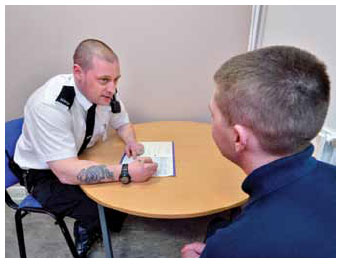
HMYOI Polmont - positive interaction
I would like to pay tribute to the Scottish Prison Service (SPS). Throughout my time as Chief Inspector I have come to respect the tremendous work carried out by Prison Officers. They are in constant charge of some of Scotland's most dangerous, challenging and vulnerable people. This is a very important responsibility demonstrating high standards of care and safe custody. I continue to encourage the SPS to highlight the bravery and commitment of prison officers; I would like prison officers to feel more valued not just by the SPS but by the country as a whole. In my first Annual Report I wrote:
"… I have gained an impression of an organisation, the Scottish Prison Service, that hides its light under a bushel. It has much to be proud of and yet it spends much of its time being defensive. It is the custodian of many of Scotland's most vulnerable and, in some cases, most threatening and dangerous people. As I have already suggested, in general, it looks after them safely and well … It is my view that the Scottish Prison Service does an essential job soundly and with great care; I challenge them to communicate this in a more positive fashion in Scotland."
In the past year there has been a real attempt to address this issue, but this needs a constantly proactive approach at all levels. Good reputation is a priceless commodity that needs to be carefully cultivated.
Since May 2012, when Colin McConnell took over as Chief Executive of the SPS, he has realised the need for transformational change within the Service having accepted many of the systemic issues reported on by the Inspectorate.
And so he has set in train an Organisational Review (in to which I have had input), essentially the process to address the transformational change required. This is the sort of complete change which challenges the very best of organisations, but much needs to be challenged as I have previously reported. In particular the Service needs an improved governance structure at Headquarters, much improved training and development of staff to bring on managers and teach leadership and better management. The best organisations carry out such training and I very much hope the SPS will embrace this approach in the future.
Colin McConnell's approach has already begun to bear fruit. For example we have seen a positive response to the recommendations from the report of the Commission on Women Offenders, led so ably by Dame Elish Angiolini. I have been delighted to hear that a family visitor centre will be provided at Cornton Vale as visible proof that change is happening. This is a very positive volte face and one that I applaud loudly. Indeed the whole culture is changing. There is now a much more positive attitude to a number of the issues I have reported upon and I have been particularly pleased by the open and helpful manner in which inspection reports are now received.

HMP Addiewell - Kiosk
There is still much to be done to take the SPS forward and I would like to think the SPS Board is constantly asking "where will the SPS be in 10 years' time?" I have often criticised the SPS for failing to grasp the importance of having a Vision and Strategy (and this was most notable in their response to my first report on Cornton Vale in 2009). One result of this has been poor investment in modern technology as new and re-developed prisons have been built. Let me quote from the Scottish Parliament Justice Committee Report on Purposeful Activity in Prisons (JUS/S4/13/R5)[8]:
"HMCIPS has championed the better timetabling of activities since he took up post in 2009. He argues that the effectiveness of purposeful activities would be maximised if timetables were used to schedule activities, thus avoiding clashes. He argues in his submission that the "scheduling of activities in this fashion is to be encouraged if optimum access is to be achieved".
In putting forward his case, HMCIPS has highlighted the use of computerised prisoner management systems at the two private prisons, HMP Addiewell and HMP Kilmarnock. He argues that:
"Computerised prisoner management technology is put to good effect in both private prisons … to record and measure the volume of prisoner activity. These systems are also the vehicle used to produce and interpret the data which, among other things, informs changes to the menu of activities available to prisoners and indicates the demand for activities. These systems also have the capability to produce individual timetables for prisoners and provide automatic calculations for the payment of their wage earnings. Public sector prisons are reliant on a manual data input system which provides none of the additional benefits enjoyed by more sophisticated technology."
HMCIPS reiterated his disappointment that computerised prisoner management systems have not been installed in HMP Low Moss and HMP Shotts, newly opened and recently re-built prisons respectively, to the Committee when he gave oral evidence and expressed a hope that they will be installed in HMP Inverclyde which is currently under development."
It is my strong recommendation that SPS review how they intend to manage prisoners in the future and that they install computerised prisoner management technology as part of this vision for the future.
In the shorter term one particular aspect that needs to be addressed is the effectiveness of Personal Officers as one of the means to support and guide prisoners through their time in custody. In my third Annual Report I wrote[9]:
"In terms of preparing prisoners for release, one of the most valuable assets within the SPS are Residential Officers. It is essential, in my view, that these officers are properly trained as Personal Officers so that they can mentor prisoners to engage in preparation for release, including the ICM and prison progression process. Although some prisons use the Personal Officer Scheme well, I feel there has been little progress on this resource and I have regularly commented on how poorly the Scheme works. Given the cost of Residential Officers, this poor situation represents poor value for money in my opinion. As I write this, there is still no Job Description or training for such officers. The Personal Officer Scheme[10], if well designed and implemented, could make a significant difference to how prisoners are mentored and prepared for re integration. I recommend that the SPS Board urgently reviews the Scheme and implements recommendations to improve it."
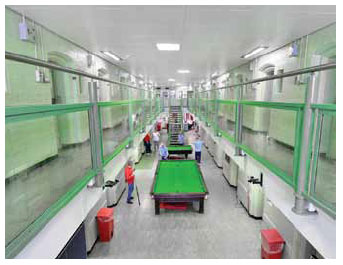
HMP Barlinnie - Residential Hall
As a result of my inspections this year, I can report that little has improved with regard to the use of Personal Officers. It is my belief that challenging prisoners about their behaviour is one of the best ways to support them and to help them adjust and improve their chances. Many prisons have a basic Personal Officer Scheme that is functioning, but very few Personal Officers have been trained in the role and there is no centralised SPS 'train-the-trainer' course so that prisons can train their own officers quickly, effectively and to a common standard. Consequently few Personal Officers understand their wider role in helping prisoners to take advantage of the opportunities available and to apply these to progressing prisoners. I quote from my report on HMYOI Polmont[11]: "Personal Officers do not work sufficiently with young offenders to support them in achieving the outcomes identified in their Community Integration Plans."
The Personal Officer Scheme is a 'quick win' as it should already exist. I again urge the SPS to produce a comprehensive training scheme to ensure that Personal Officers and their managers are properly trained, managed and supervised for this vital role.
Since my very first weeks as Chief Inspector, visiting all of Scotland's prisons, I have worried about the lack of a coherent career-development strategy for prison staff. When I listen to staff focus groups, many feel a lack of investment in their personal development and training. I remain convinced that the SPS needs a fully-resourced training and personal development system that prepares staff, not only for the job they are doing or are about to do, but also to build up a cadre of potential managers for the future. There also needs to be a process of learning within the SPS to ensure that lessons learned, good practice and poor practice is appropriately dealt with.
In summary, I am more optimistic about the future effectiveness of the SPS, knowing that change and improvement are at the top of the Service's agenda. Yet transformational change can be a risky process requiring clear and explicit ways of communicating at all times, if all staff are to understand their part in changes. For this reason it will be ever more important for the Chief Inspector and the Inspectorate to be closely involved in order to ensure that the treatment of prisoners remains a high priority.
The Inspectorate
Throughout my period as Chief Inspector I have been wisely guided and supported by the Inspectorate, with a permanent team of only four, one of the smallest 'scrutiny bodies' in the United Kingdom. My first Deputy, John McCaig introduced me to 'prison' and guided me through my first inspection. In 2010 Kate Donegan took over and provided the leadership to deal with the very serious issues facing the SPS with regard to Cornton Vale women's prison. Without doubt her vision and leadership set the standard that is taking the prison forward now. Margaret Brown, my current Deputy since 2011 has led the Inspectorate through a significant period of change as we have taken on new inspectors and have provided new ways of inspecting and reporting. Her vision has set the standard for the future. I thank them all for their dedication and hard work.
Not only have I been supported by a tremendous 'home team' in the Inspectorate, but I have also greatly appreciated the support and expertise I have received from Education Scotland Inspectors, from Healthcare Improvement Scotland Inspectors and from Guest and Associate Inspectors from the SPS. The combination of their common sense, inspecting skills and, of course their specific knowledge has proved to be a powerful inspecting and reporting tool. This is all good value for money. I also believe that working with the Inspectorate is an excellent development opportunity for visiting inspectors.
As I leave the Inspectorate I can report significant change is taking place:
- The Standards for Inspecting Prisons in Scotland (2006) are being re-written and will be put through a comprehensive consultation and application process prior to being introduced next year. These Standards are the baseline against which all inspections and prison monitoring takes place.
- Prison inspections are carried out on a risk and needs basis. These are supported by shorter formal visits to support prisons that are either due to close (eg HMP Aberdeen) or do not merit full inspection in the next year (eg HMP Dumfries). The combination of these measures should ensure a more comprehensive inspection regime.
- The Chief Inspector will be given the responsibility for overseeing the monitoring of prisons in Scotland. I report more on this function below.
Main Issues
Young People and the Prevention Agenda
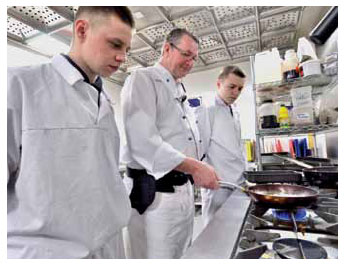
HMYOI Polmont - catering training kitchen
Throughout my time as Chief Inspector I have tried to take a view about youth offending because Scotland's greatest asset is her young people. If the cycle of reoffending is to be broken, it will be broken by addressing the critical early years before school and those years when children are at school and especially that important time when children move from primary to secondary education. I have been much heartened by action to address these vital early years.
But I have also worried about the routes that children take towards offending behaviour. In my second Annual Report[12] I wrote:
"Prisoners tell me that this same landscape also excludes them from school. Indeed many young offenders hardly attend school from the ages of 13 or 14 onwards. Therefore they have little understanding about responsibility, aspiration or the need to become qualified to get a job. It is during this time of exclusion (a term I use in both a physical and a moral context) that young people get involved with alcohol, violence and possibly early experimentation with drugs. They may even be in regular contact with adult drug dealers."
Last year I was able to report about some of the inspiring projects I had seen at Dunfermline High School and at Spartans Community Football Academy[13]:
"Firstly, and as a direct result of my call in last year's Annual Report for more inclusion at schools, I visited the Inclusion Unit at Dunfermline High School. Here the determination is that disruptive and challenging children are not excluded but included and spend time within the Inclusion Unit. I was impressed by the youngsters whose lives are being turned around by the Unit, which is staffed, not by teachers but by APEX Scotland employees. As a result, school exclusions are down by 75% and there is real hope amongst the youngsters I see that they will get to college and go on to get a job.
My second example is a recent visit I made to the Spartans Community Football Academy in North Edinburgh, which opened in December 2008. This is a true community youth club, using football as the primary vehicle to attract in youngsters and to encourage them to participate and to socialise. The club's vision is to provide a community inspired, developed and managed facility, to help develop people of all ages in sporting, social and life skills."
During this inspection year I inspected HMYOI Polmont. In my report on the establishment I said[14]: "For young offenders, and especially for those aged under 18, I perceive Polmont as the last chance to re-shape young lives, the final opportunity to enter society in a positive way and move away from the risk of reoffending (and these risks are currently higher for male young offenders than for other groups)." Yet I went on to say: "The HMYOI Polmont regime appears to do little to encourage aspiration and it is suggested that the whole regime and the management of it needs to be reviewed."
My conclusion is that, currently, custody is not giving these young people the inspiration and direction they need (although I am optimistic that, in time, new learning opportunities will mean this situation may change). Therefore more needs to be done to prevent youngsters getting in to the position of making wrong choices in the first place.
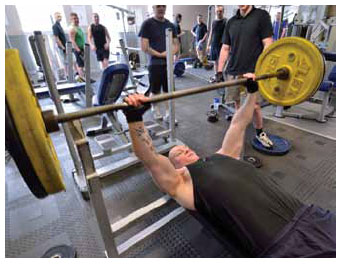
HMYOI Polmont - exercise
According to many young offenders I speak to, particularly those living in postcodes where the risks of offending are high, they have no experience of positive, adult role models and have witnessed trauma, particularly related to multiple bereavements, many of which were the result of violence. They are bored often due to a lack of extra curricular stimulation. There may be very little to do outside school hours and this situation is not helped by school exclusion. I have often encouraged greater use of extra curricular activity including the use of sport, youth movements and the arts as ways to engage with young people out of school hours in order to provide them with interests, socialisation, behavioural boundaries, role models, values and standards. A recipe of combining such activities with education could have extraordinary results.
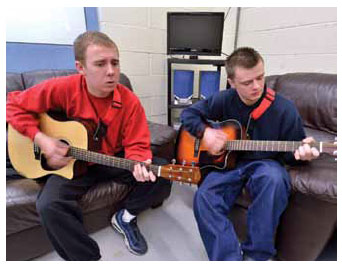
HMYOI Polmont - making music
I continue to call for a new approach to extra-curricular activities for young people with a priority given to areas of deprivation. I am encouraged by those sports clubs, for example, who have made such excellent connections with local schools in order to improve the sporting experience for young people. The same is true for many other organisations whose values and energy make such a difference. I have been very struck by the range of enthusiastic and committed adults, often volunteers in a range of different organisations, who give so much of their lives to help young people develop. I believe a new approach to extra-curricular activities could bring significant and long-lasting benefits.
I have learnt much from speaking to young offenders in Polmont and in Cornton Vale. In essence, society can do a lot more to prevent young people from offending. Equally much more investment and care is required to ensure those that do offend have a much better chance of succeeding in society on release from our young offender institutions. I am pleased to note the positive progress the new and refreshing approach taken by the SPS, in partnership with Education Scotland in terms of improving life choices for those in HMYOI Polmont.
Female Offenders (HMCIPS Priority 1)
Of all issues, I have been most vocal on the issue of Cornton Vale, a prison I first inspected in September 2009[15]. At that time the prison was badly overcrowded and I commented: "Cornton Vale is in a state of crisis and an ever increasing prison population is one of the main causes; indeed many of the criticisms I have are directly related to this situation." It was clear to me that the prison was lacking in strategic investment and leadership and that it had a lower investment priority than other prisons.
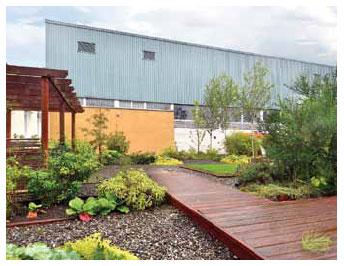
HMP & YOI Cornton Vale garden
I went on to say: "The issues affecting the population that the staff face are very complex and challenging, yet Cornton Vale appears to lack the priority that it needs in terms of staffing and resourcing. It is my first recommendation that female prisoners need a focus at SPS Board level, with a view to setting the agenda for the future and ensuring such an agenda is implemented quickly and with purpose. This report makes specific recommendations about how this prison could be quickly and efficiently turned round." Unfortunately this recommendation went unheeded and as a result of my second inspection a year later I wrote[16]: "… and there remains a need for improved and strong national and local leadership to deal with the shocking and challenging issues in the prison."
We should not forget the seriousness of some of the issues in Cornton Vale. I criticised massive overcrowding, poor treatment of prisoners, poor treatment of women with mental health issues, very poor access to activity and poor leadership at all levels. There are two issues which I use as examples of how bad things were in the prison. The first is that in two house blocks, access to the toilet, the most basic human need of all was 'disgracefully poor'. Prisoners were reportedly waiting for over one hour to go to the toilet. Not only was this appalling treatment of prisoners, but it was distinctly unhealthy and degrading. It demonstrated to me the negative culture within the prison.
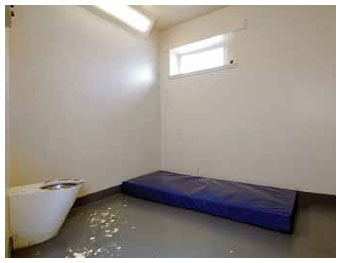
HMP & YOI Cornton Vale - Ross House back cells - now closed
The second was the use of 'back cells' in Ross House and latterly in Younger House to segregate and hold vulnerable and disturbed women. These cells were not only utterly unacceptable, but in the case of Younger House, wholly unsuitable. To quote from my second follow up report[17]: "Unfortunately, during the inspection, some such prisoners were being held on a temporary basis in 'silent cells' in Younger House. This was not only inappropriate use of such cells, but the conditions were disgracefully poor: I saw one prisoner lying on a mattress on a concrete plinth and there was no window to provide ventilation or light. On moral and health grounds these cells are unacceptable." I tried to close these cells with immediate effect, but the Chief Inspector does not have such power. Never again must such disgraceful conditions be allowed to occur. A shameful part of our history.
Only with the publication of the Chief Inspector's Second Report was action taken with the convening of the Commission on Women Offenders and the transfer of 114 female prisoners to HMP Edinburgh. As a result of Dame Elish Angiolini's Commission[18] significant recommendations were offered to improve the lot of female offenders, many of them mirroring recommendations of the Inspectorate. Only since the wholehearted acceptance by the SPS of the Commission's report in 2012 and the appointment of Kate Donegan as Governor, have I felt that the treatment of female offenders at the prison has begun to improve. The Chief Executive himself has now taken responsibility for the treatment and conditions of female prisoners. Conditions have also improved and will continue to do so as accommodation at Cornton Vale is upgraded and when HMP Inverclyde is opened as the replacement for Cornton Vale.
Specific examples of this improvement are:
- The opening of a new Prisoner Visitor Centre at Cornton Vale. This was initially recommended in the 2009 inspection report and also by the Angiolini Commission.
- The opening of Dumyat House, a new Separation and Reintegration Unit in 2012 to replace the 'back cells' in Ross House.
- The significant upgrading of prisoner accommodation in Peebles, Bruce and Younger Houses. This includes replacing cell furniture; toilets and showers; flooring and repainting all areas. The five safer cells in Ross House will also be upgraded. With the refurbishment of Cornton Vale's main gate area, both the environment and physical security will be significantly improved.
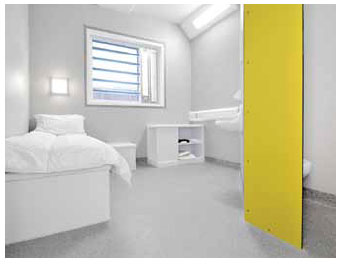
HMP & YOI Cornton Vale - Dumyat Separation and Reintegration Unit
In the short term I am therefore satisfied that female prisoners are being well treated at Cornton Vale, Edinburgh and Greenock and that there is a satisfactory long-term goal of opening a new female prison at Greenock, HMP Inverclyde, to replace Cornton Vale, also with a new female wing at HMP Edinburgh. A formal visit inspection to Cornton Vale will occur in January 2014. In summary, female offenders will be significantly better looked after by 2018 than in 2009. Nevertheless it has taken too long to make this progress.
Family Access (HMCIPS Priority 2)

HMP Addiewell - opening of visitors centre
Last year I reported: "I see good family access as being very important in two vital areas. Firstly to ensure the best possible rehabilitation of the prisoner back in to the community. Secondly to ensure that families are supported and advised in the best possible way both in terms of their own situation and also with regard to the prisoner's rehabilitation. If both these areas are effective then the chances of success are enhanced." By 'situation' I mean the need to signpost for families community services that might help them to better support their family member on release back in the community. I stand by that view.
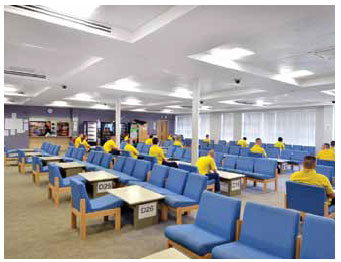
HMYOI Polmont visit room
For too long prisoner families have been stigmatised, yet it is the family that can make the difference in helping an offender succeed in the community rather than reoffend. It takes a strong supporting framework to help families achieve this and that is why I have been so vociferous about the need for Prisoner Visitor Centres at every prison. 'Prison' is particularly difficult for the children of prisoners and there is always a risk that the children of prisoners will graduate in to prison themselves. I meet far too many third or fourth generation prisoners.
In terms of rehabilitation, the family should be as involved as possible in the Integrated Case Management (ICM) process to better understand the prisoner's situation and also their needs on their return to the community. Yet the family attendance figures at ICM case conferences are poor and suggest that insufficient emphasis is put on family involvement. At Polmont we found that out of 132 ICM case conferences between April and September 2012, only 22 involved family members. This is a surprisingly low figure for a young offenders institution[19].
I am satisfied that there has been a complete change of approach by SPS Headquarters during the past 12 months. The new HMP Grampian will now contain a Family Help Hub, fully supported by Third Sector organisations and the plans for HMP Inverclyde will also include a Visitor Centre. Along with the new Centre at Cornton Vale, this is real progress. A family centre has been opened at Addiewell in the front entrance hall and I am hopeful this will be a success. I see Prisoner Visitor Centres as critically important parts of keeping families stable during that stressful period while a family member is in prison and therefore of improving the chances of success for that prisoner.
I have seen many other initiatives in a number of prisons, such as the family strategy work at Low Moss, which includes a range of family activities for children, such as Scouts and Guides, dance classes and 'book bug' reading and singing. These are good activities not only to improve family contact, but also to give children positive introductions to other activities.
Finally I applaud the efforts of the Prisoner Visitor Centre Steering Group, supported by the Scottish Government Youth Justice Team, the SPS and with the Church of Scotland, CrossReach, Families Outside and other Third Sector organisations very much to the fore. This is bringing together not only the vision for a Centre at every prison, but also developing the idea of what such Centres can do to help the families of prisoners. Now there is real hope for the future.
Purposeful Activity in Prison (HMCIPS Priority 3)
Throughout my period as Chief Inspector I have been commenting on poor quality of activity and also poor access to activities:
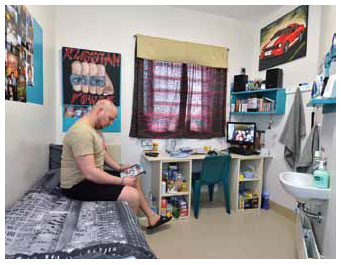
HMP Shotts - in cell time
Four years ago I wrote[20]: "… when I visit or inspect prisons, I see too many prisoners in halls or cells rather than taking part in gainful activity." In the 2010-11 Annual Report[21]: "In essence, I am calling for an improvement in the opportunities for access to gainful activity. It is my assessment that over the years activities, and particularly work, have been reduced. I strongly recommend that this process is reversed." In last year's Annual Report[22]: "I conclude this section by stating that the current poor access to purposeful activities is not acceptable and contributes to a negative picture when considering whether prison is working."
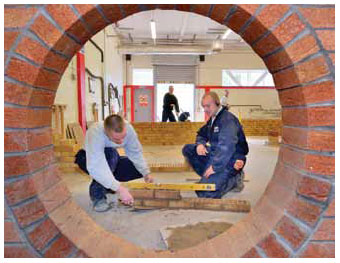
HMYOI Polmont - vocational training
In almost every prison inspection report I comment negatively on poor access to purposeful activity. On HMYOI Polmont[23]: "Related to this, access to purposeful activity at Polmont is not as good as it could be. The establishment has excellent facilities and some high grade instructors and teachers, but they are not being fully utilised, both because there are insufficient instructors to cover for sickness, leave and staff training, but also because poor 'timetabling' does not ensure the maximum number of young offenders are in the right place at the right time." At the time of the inspection, of the 200 activity spaces available, only 84 were filled. "Additionally, only 29 young offenders attended the Learning Centre when 80 spaces were in fact available on that day."[24]
On the Open Estate[25]: "I am worried about the general feeling of boredom and poor quality of recreation. Except for the gym there is very little for prisoners to do, although this situation may improve during the summer months with the provision of garden allotments for a few prisoners."

HMP Open Estate - allotments
At last this issue has arrived on the National Agenda with the 'Inquiry into Purposeful Activity in Prisons' by the Justice Committee, the report being published in March 2013[26]. I was invited to give oral and written evidence to the Committee. The Report provides a number of helpful conclusions and recommendations. Most importantly it states in the Executive Summary: "The Committee believes that purposeful activities are an important way of delivering support and the necessary key skills for prisoners to achieve many of the national offender outcomes. The Committee believes, therefore, that the provision of purposeful activities should be at the centre of rehabilitation policies delivered in prisons."
I strongly support the Committee's Report and especially the recommendation that urges the SPS to draft a strategy relating to purposeful activities. As part of my written evidence to the Committee I stated that the Inspectorate had revisited a number of prisons recently inspected to ascertain whether access to purposeful activity had improved since the inspection. I was able to report that in those prisons (Cornton Vale, Glenochil, Kilmarnock, Barlinnie and Dumfries) considerable efforts had been made to improve access to purposeful activities. Whilst I commend these efforts, it is my view that the provision of activities is still not at the very centre of rehabilitation policy and much still needs to be done to change the way that prisoners are given the opportunity to improve. I reiterate the point that the quality of activities must also improve, so that work is productive and useful, that vocational training is assessed and provides a useful qualification for employment and that education is related to prisoners' needs.

HMP Shotts - Occupational training workshop
Finally, and most importantly, I continue to worry that prisoners on remand have the poorest access to purposeful activity and this specific issue needs to be addressed as a matter of priority in any review.

HMP Open Estate - Education
The standard of education and learning in prison is variable. In most instances it is governed by the contract between the SPS and either Motherwell or Carnegie Colleges. It is my view that this contract is proving to be too inflexible and there is too much emphasis on 'numeracy and literacy'. Whilst this emphasis may have been made with good intentions it has proved either to be inappropriate or discouraging. Inappropriate because not all prisons or prisoners should be concentrating on numeracy or literacy. In my report on the Open Estate, for example, I said: "... [the contract] emphasises literacy and numeracy, yet the Open Estate needs to be more focused on employability training[27]." Discouraging because such an approach to education is seen by many young offenders and prisoners as 'going back to school' where so many of them 'failed'.
Learning in prison requires a much more inclusive approach that connects with prisoners. The Polmont Report states[28]: "Around 45% of young offenders access education programmes. Educational opportunities are good during weekdays. However, too many young offenders from Blair House (for under 18 year olds) do not participate sufficiently in education because they remain in their cells for long periods during the day."
Measuring progress in the education contract is often done by counting numbers; 'how many' prisoners attended this or that. I would like to see more measurement by outcome in order to assess what is really being achieved.
Nevertheless I do not underestimate the generally positive nature of education opportunities in prison for those who can access them. I have been impressed by a range of educational activities including art, music and other activities such as the radio station and Paws for Progress in Polmont.

HMYOI Polmont - Radio station
It is widely recognised and reported by me that Learning, Skills and Employability would benefit from secure access to the internet. I note that the SPS is considering whether prisoners should have limited secure access to the internet. I support this as it would allow prisoners greater access to Government publications, learning and appropriate services pre release. Such access would greatly support learners and would continue to help them on release back in the community. There are, of course, security concerns that until recently has been an overriding issue for the SPS, but modern technology would allow the SPS to address this. I continue to support moves to bring in secure internet access to education centres as soon as possible.

HMP Glenochil - IT training

HMYOI Polmont - time in cell
In summary, the most dispiriting aspect of visiting prison is to find a significant proportion of prisoners or young offenders in halls or their cells during the working day. As I reported in the Report on Polmont, some young offenders are still in their beds in the afternoon. Watching day-time television is not, in my view, a substitute for purposeful activity. It is merely a recognition that there are insufficient activity places for prisoners and, sadly, poor motivation to encourage prisoners to engage. I agree with the Justice Committee that there needs to be a strategic shift in the way that prisoners are rehabilitated and this will require a review by the SPS. The taxpayer expects two things from prison: firstly, loss of liberty as punishment and secondly, rehabilitation to reduce the chances of Reoffending. The latter needs better organisation and resourcing and a great deal more attention.
Preparation for Release (HMCIPS Priority 4)

HMP Shotts - Library
In last year's Annual Report I said: "Preparation for release should, in my view, be at the very centre of prison activity; it is a main reason why the State sends offenders to prison so that on release they can take their place in society with the very best chance of success[29]."
This year I have inspected prisons with very different parts to play in the process. Shotts, where long-term prisoners are held, has to have an approach tailored for individuals who may serve very long sentences indeed. Polmont, the male young offender institution, where the staff will have a real influence on "re-shaping young lives, the final opportunity to enter society in a positive way and move away from the risks of offending". And the Open Estate, the final stage in a prisoner's progression back to the community.

HMP Open Estate - community work placement
Reducing reoffending must be the yardstick by which prisons are measured in terms of preparation for release. The audit carried out by Audit Scotland, 'Reducing Reoffending in Scotland' (November 2012)[30] is a useful report to review the current situation. This report sets out the cost of services and activities aimed specifically at Reoffending at £128 million in 2010-11 and puts the total spent by the SPS, CJAs and the Scottish Government in the same year dealing with convicted offenders at £419 million.
The report goes on to set the reconviction figures starkly: "In 2009-10, over 47,000 people were convicted of an offence and 30% (over 14,000 people) were reconvicted within one year." With regards to men under 21: "Over a third of this group who were convicted in 2009-10 reoffended within one year compared to just over a quarter of men aged over 30." This sets out the importance of HMYOI Polmont in trying to reduce reoffending and why I stated in my report on Polmont: "In Blair House (for under 18s) there was little evidence of throughcare working with partners either as under 18s entered HMYOI Polmont or indeed to ensure better opportunities for success on release." Outside of prison great progress has been made in a number of initiatives such as the Whole Systems Approach to reduce reoffending by young people. Now we need to see much stronger links between YOIs, prisons and communities to deliver even better outcomes.

HMP Addiewell - Link Centre
I have often argued that liberation from prison needs to be improved, yet the links between prison and services in the community have undoubtedly improved in recent years. Prison Link Centres are an excellent service to join prisoners to essential services such as housing, benefits and employment. I commend those who work in Link Centres for the excellent work they do. Now there need to be improvements in those areas set out by Audit Scotland: "However, there appears to be only a limited relationship between the services offered to offenders … and what is known to be effective. The majority of services cover three outcome areas - employability, health and addictions and influencing thinking and behaviour. Few are provided on money and debt management, motivation or families and relationships." I agree with this view.
To improve this situation I have argued that there should be more widespread use of mentors to encourage, guide and support released offenders in those critical first weeks of freedom. Some prisons, such as Greenock, are trying to bridge that gap by employing officers to work with offenders in the community on release. Others such as Low Moss are setting up Public Sector Partnerships in order to integrate Third Sector and public throughcare services more coherently. I would like to see a more comprehensive and combined strategy, led from SPS Headquarters, perhaps starting by prioritising under 18s. In the Polmont Report I suggest: "Improved partnership working is critical if Reducing Reoffending Phase 2 (RRP2) is to succeed. There would be considerable merit in considering how to deliver young offenders in a better way in to the community. It could be argued that every young person from Blair House should be individually mentored throughout the process of moving back in to the community." A vision to mentor every prisoner through the whole liberation process could deliver impressive dividends across the prison estate.
Other Issues
Overcrowding

HMP Barlinnie - cell sharing
Last year I reported: "The year has been marked by overcrowding in prisons, an unwelcome issue which has returned. Prison numbers reached a record 8,461 in March 2012, up by 469 on the previous March." As at the end of March 2013, I am able to report that the prison population has stabilised at 7,781 and I am particularly pleased that the number of male young offenders in prison has reduced by about 100. Given the continued reduction in the crime rate both in Scotland and across the United Kingdom, it is a good sign that the upward trend appears to have halted, although it is too early to say whether this is a long-term situation.
Long-term projections suggest that, far from falling, the prison population will rise in the coming years. During my tenure as Chief Inspector, I have learnt that overcrowding has a very negative effect. This was most obvious in Cornton Vale where far too many female offenders were housed until the population was reduced by moving 114 prisoners to HMP Edinburgh. As I have already expressed in this report, overcrowding meant very poor access to activities and poor access to basic amenities such as toilets. The reduction in the population ensured a dramatic improvement. Too often I see single cells occupied by two prisoners. This produces poor conditions and increases the risk of violence.
Overcrowding in prisons is counter-productive and does little to improve the Reducing Reoffending Programme in the widest sense. At present, prisons must take offenders from courts, sentenced or untried, whatever the consequences on the management of the prison. I suggest that clearer guidelines are set out to show the impact of overcrowding on each prison in an effort to manage the situation.

HMYOI Polmont - prisoner reception
As ever, I worry there are too many prisoners on remand and I continue to question imprisonment when many are subsequently not given a custodial sentence.
In summary, overcrowding is a malaise that should be addressed before it becomes a serious issue once again. The Prisons Commission in its report stated: "The Commission recommends that the Government pursue a target of reducing the prison population to an average daily population of 5,000[31]." I continue to support this target.
Dealing with Underlying Offending Behaviour
Most offenders are in prison because of an underlying issue. Much useful work has been undertaken in recent years to identify forms of behaviour, such as alcohol or drug misuse, poorly regulated use of anger and exploitative sexual attitudes, which have been shown to be frequently associated with criminal activity. Based on psychological assessments, prisons run a range of programmes to deal with such issues. These programmes are not only important to improve prisoners' ability to cope, but are also an important part of the risk assessment and prisoner progression process. Some programmes, such as the Violence Prevention Programme (VPP) are lengthy and very demanding of prisoners and consequently expensive to run. Yet I have not seen any assessment of how effective such courses are, although the Parole Board expect to see that long-term prisoners have successfully completed such courses before agreeing to any prisoner progression towards Open Conditions or release.
I have no doubt that programmes are a vital part of the process of improvement, but I am concerned that there is currently no way to measure how successful these are when offenders are released back in to the community. This picture is compounded by the difficulty in assessing this performance by CJAs as set out in Audit Scotland's report in to Reducing Reoffending in Scotland (November 2012). I strongly support the recommendation in that report which states: "The Scottish Government should improve the range of performance measures to assess the effectiveness of SPS, CJAs and councils in reducing reoffending." There will be a temptation to produce yet more targets and Key Performance Indicators. It is my view that there would be merit in producing less of a target-driven 'how many' culture and designing a performance measurement system for the SPS that is much more related to the delivery of outcomes.
Prison Monitoring
As a result of the Scottish Government decision to replace Scotland's Visiting Committees (VCs) I have been determined that our prisons are checked regularly by independent monitors. Any new arrangements must meet the National Preventive Mechanism (NPM) requirements set to achieve the OPCAT[32] standards.
When the Scottish Government announced that VCs would be replaced by an advocacy service I joined the NPM in calling for regular and independent prison monitoring and I have been heartened by the Government's positive response to that.
My contribution has been to design a structure for the Chief Inspector of Prisons to take on the responsibility of supporting a new monitoring service, separate from the 'Inspectorate' and closely linked to local communities, making best use of volunteer 'lay' monitors. My proposal has been to use salaried regional monitors to recruit, train and support the lay monitors.
The Cabinet Secretary's announcement that the Chief Inspector of Prisons for Scotland is best placed to oversee the independent monitoring of prisons in Scotland is welcomed. Such an arrangement will provide a framework for independent prison monitoring that has the potential to become the benchmark for OPCAT. Importantly, the Scottish tradition of including local, lay, people to monitor prisons will continue and will be enhanced through improved training and support. Further, I am delighted that an advisory group from representatives of civil society will provide guidance on monitoring, appointments and training. Added to the separate function of inspecting prisons, oversight of monitoring will give the Chief Inspector of Prisons a more constant and accurate picture of Scotland's prisons.
Now that the Government have given approval to this option, the Chief Inspector, subject to Parliamentary approval, will become responsible for both inspecting and monitoring. The advantage of the Chief Inspector having these responsibilities is the much better flow of information between the two separate functions. Until now this has been poor, but can now be fully integrated, using new processes and reporting methods. This will greatly improve the way that our prisons are reported on. It is also important that the SPS and the public receive a comprehensive message, based on evidence coming from the same source and judged against the same inspecting Standards. In summary this will be a unique system and will put Scotland at the 'cutting edge' of prison scrutiny.
Use of Video Courts
I have been calling for greater use of video link technology for pre-trial hearings since my very first inspection of Cornton Vale in 2009. I am delighted to be able to report that the SPS video conferencing project is part of a National Cross Justice Video Conferencing Project within the Making Justice Work Programme. I fully support the vision of the project that "…no individual who is detained in prison or police custody will need to travel to or from the proper administration of justice in Scotland unless necessary or more convenient to do so."
There are two pilot projects which are being established, one in respect of video links from prisons with the High Court and the other with legal agents carrying out consultations by video link from their offices with their clients in prison. Given the complexities involved, this appears to be a sensible way forward and I support these initiatives.
Summary
This has been a significant period and much has been achieved to take forward the scrutiny of prisons in Scotland. Strategic change is being achieved by the SPS and the examples of improvements for women offenders and for improved family contact with prisoners merit inclusion here. But much has still to be done to reach a standard across the board that is acceptable for the long term. For example, if purposeful activity within prison is to provide that life changing element that will really help to reduce reoffending, particularly for young offenders, then significant improvements in quantity and quality will be required.
And finally:

Slopping out - a thing of the past;

HMYOI Polmont - integral sanitation
The First Annual Report by HM Chief Inspector of Prisons for Scotland, then Mr D A P Barrie CBE, was published almost exactly 32 years ago[33]. When reading this report it is obvious what vast improvements have been made over the years. The discontinued practice of 'slopping out' being replaced by integral sanitation is the most obvious one; 'reading between the lines' it is clear that in almost every respect, conditions for prisoners have improved, particularly in the majority of our prisons which are either entirely new or recently re-developed. The opening of HMP Grampian and then subsequently, HMP Inverclyde will make that picture even better. My predecessors earned great respect with what they achieved as their part in this greatly improved situation.
Not surprisingly some of the issues raised in my final report also appeared in the very first Chief Inspector's report:
- "The demands upon penal establishments are determined by other agencies and it is to the credit of management and staff at all levels that the Scottish Prison Service has operated both effectively and efficiently during 1981."
- "The Inspectors found that overcrowding invariably results in a poor quality of regime and limited occupational and other facilities."
- "The Statutory Rules require that all convicted inmates … should be gainfully employed and those on remand be afforded the opportunity to work if they so wish … The present situation makes it necessary to confine many short-term inmates in their cells."
- "... many question the grounds on which custodial remand is ordered."
So, a considerable amount has changed for the better, but, for the Inspectorate, much still remains to be achieved.
Hugh Monro CBE
HM Chief Inspector of Prisons for Scotland
June 2013
2. SUMMARY OF INSPECTIONS UNDERTAKEN
Establishments
HMP Open Estate
Full Inspection 23-29 April 2012
Summary
Safety
The Open Estate is safe. Prisoners who have mental health, alcohol or drug problems, or are at risk of self-harm or are vulnerable for other reasons are provided with appropriate services and support and are safe. Prisoners are protected from harm by other prisoners. The Open Estate has integrated former Noranside prisoners well. The Open Estate is largely free of violence and bullying. At the time of the inspection, no prisoners had been indentified as being at risk from bullying or harassment.
The Open Estate has appropriate arrangements in place for responding to emergency situations. However, it does not ensure that all relevant staff are fully trained in dealing with such emergencies.
Force is very rarely used at the Open Estate and then in accordance with law and procedures.
The Open Estate has transparent procedures in place for revising the supervision level applied to prisoners. Prisoners who are returned to the 'closed estate' are provided with the reasons for the decision and information on how they can contribute to having their level of supervision revised.
Decency, Humanity and Respect for Legal Rights
The Open Estate ensures that prisoners are treated with decency, humanity and that their legal rights are respected.
Prisoners have adequate in-cell space, natural light and ventilation. Cells are well maintained. Prisoners have access to drinking water and toilet and showering facilities. Some toilet and showering facilities do not fully meet basic hygiene requirements and do not provide sufficient privacy. Food is adequate for health, varied and religiously and culturally appropriate.
The Open Estate provides prisoners with excellent access to the open air and to exercise.
Relationships between prisoners and members of staff are good. Prisoners are treated with respect by members of staff. Staff in the Open Estate seek to stop prisoners being returned to closed conditions by emphasising the consequences of offending against good order and discipline. This is often interpreted by prisoners negatively with many reporting that they felt threatened with being returned to closed conditions for what they regarded as being trivial reasons. This is a weakness and detracts from the general positive atmosphere that exists.
Prisoners are able to receive visits from their friends and family. The Open Estate is a national facility and is not fully served by public transport. Travelling to the Open Estate is a challenge for many families particularly in inclement weather, if travelling with children or if visitors are elderly or suffer with mobility problems. Facilities for visitors would benefit from being improved.
The Open Estate provides prisoners with access to the Prison Rules and a selection of legal texts. It seeks to ensure that prisoners are able to access their legal rights, but provides insufficient information on how they can access Members of Parliament, Visiting Committees and the Courts should they wish to raise a concern.
Prisoners have good access to telephones and postal services. Legally privileged correspondence is dealt with appropriately.
The Open Estate deals fairly and justly with prisoners who are the subject of disciplinary hearings.
The Open Estate does not routinely use Holding Cells. When Holding Cells are used prisoners are only placed in these cells for a short time and in accordance with policy and procedures.
Opportunities for Self-Improvement and Access to Services and Activities
All prisoners are provided with induction sessions on their arrival at the Open Estate. These do not sufficiently encourage prisoners to influence what happens to them while at the Open Estate or to fully engage with the employment, work, education, training or other opportunities that are available to them.
The Open Estate provides prisoners with a range of educational, training, in-prison work, community work placements and other activities to make the most of their time at the Open Estate and to prepare them for release.
Purposeful activities enable prisoners to enhance their existing skills, to develop new ones, to develop independent living skills and to plan for release.
The Open Estate makes good use of Integrated Case Management, Social Work, Personal Officer and other resources.
Opportunities would benefit from being more closely linked to the needs of prisoners and aligned more to the needs of the labour market.
The Open Estate provides limited educational, training, cultural and recreational activities in the evenings and at weekends. This is a weakness.
The Open Estate provides prisoners with two courses to address their offending behaviour: A Sense of Balance and the SMART Recovery programme. The Open Estate does not provide prisoners with a course seeking to address domestic violence. This is a weakness.
The Open Estate ensures that prisoners are able to practice their religion. However, the Multi-Faith Centre needs refurbished or replaced.
The Open Estate provides prisoners with a good standard of healthcare. Prisoners with issues around substance misuse are provided with appropriate services and interventions.
The Open Estate has suitable arrangements in place to assist prisoners in obtaining housing, support and other appropriate services following release.
Recommendations
For the Establishment
The Open Estate should ensure that all prisoners on transferring into the prison are given a full strip search.
The Open Estate should ensure that all prisoners' telephone calls are made on the prisoner pin phone system.
The Open Estate should develop procedures to support the SPS Anti-Bullying/Anti-Violence strategy to meet local needs and ensure that staff are aware of its content.
The Open Estate should ensure that all staff complete ACT2Care refresher training.
The Open Estate should ensure that staff callout lists are accurate.
The Open Estate should ensure that all staff required to be trained in First Aid at Work and Emergency Response have completed the required training.
The Open Estate should ensure that at least one member of staff trained in First Aid is available at all times.
The Open Estate should ensure that all staff complete Fire Awareness Training and appropriate numbers complete Fire Response Training courses 1 and 2.
The Open Estate should ensure that there are adequate staffing levels at all times.
The Open Estate should ensure that senior staff make and record regular, unannounced visits to the prison during patrol periods.
The Open Estate should take action to ensure that the provision of the Prisoner Listener Service is improved.
The Open Estate should ensure that information on how prisoners can raise safety concerns regarding bullying and violence with the Intelligence Management Unit is made more widely available.
The Open Estate should develop a local management plan to ensure that the good relations between prisoners and staff are maintained and enhanced.
The Open Estate should ensure that operational staff competence in Control and Restraint techniques (Level One) is maintained at all times.
The Open Estate should ensure that all prisoners are provided with a chair and table or workspace which is suitable for reading, writing and studying.
The Open Estate should ensure that all prisoners, regardless of location, are provided with a lockable storage facility for personal items.
The Open Estate should obtain the views of prisoners, and take appropriate action should temperature and ventilation levels become uncomfortable.
The Open Estate should connect the water dispenser in the dining room to the water supply.
The Open Estate should ensure that all prisoners employed to undertake cleaning duties are trained to the appropriate standard.
The Open Estate should take action to upgrade the ablution facilities in Bruce and Wallace Wings.
The Open Estate should upgrade the showering facilities within some areas of Bruce and Wallace Wings to ensure privacy and to meet basic hygiene requirements.
The Open Estate should ensure that the recognised prisoner meal pre-ordering system is in place.
The Open Estate should take action to increase the level of privacy afforded to the toilet facility in the dining hall.
The Open Estate should ensure that prisoners are always able to access clean cutlery at every meal.
The Open Estate should ensure that prisoners are provided with clear information on the grounds under which they may be returned to 'closed conditions' and provided with reassurance that they will not be returned to 'closed conditions' for trivial reasons.
The Open Estate should take action to promote the positive aspects of the regime and the benefits of assuming responsibility.
The Open Estate should take action to involve families in the induction process for new prisoners and ensure that they are routinely provided with relevant information.
The Open Estate should provide a shelter or waiting area for visitors.
The Open Estate should ensure that baby changing facilities are available to all visitors.
The Open Estate should ensure that the play area for children is safe and risk-free.
The Open Estate should take action to ensure that play facilities for children are fit for purpose.
The Open Estate should take action to ensure that staff are able to provide assistance to prisoners should they wish to contact Visiting Committees, Members of Parliament or the Courts.
The Open Estate should ensure that all Rule 95(1) documentation clearly states the reason why the order has been made and that they are all signed by, or on behalf of the Governor.
The Open Estate should reinstate the peer support service.
The Open Estate should take action to ensure that the quality of the full induction is improved, that sessions facilitate prisoners' retaining information and encourage them to fully engage with the opportunities available to them.
The Open Estate should increase the opportunities for prisoner involvement and consultation.
The Open Estate should ensure that the Prisoners' Forum meets on a more regular basis.
The Open Estate should ensure that the Prisoners' Forum makes progress with the issues arising.
The Open Estate should review the level of administrative support provided for the effective delivery of the Integrated Case Management process and ensure that it is adequate to meet demand.
The Open Estate should take action to enhance the provision of activities and cultural pursuits at weekends and in the evenings.
The Open Estate should ensure that purposeful activity is recorded accurately.
The Open Estate should review the provision of vocational training.
The Open Estate should ensure that resources are reviewed if placement opportunities increase to ensure that providers and prisoner participants benefit from regular support visits.
The Open Estate should evaluate the benefits prisoners gain from each placement, what each placement can offer, and use this information to support the planned progression of prisoners' capacities and attributes.
The Open Estate should improve access to education facilities and provision at weekends and in the evenings.
The Open Estate should improve the quality of Individual Learning Plans.
The Open Estate should ensure that there are sufficient toilet facilities for those using the gymnasium.
The Open Estate should take action to provide prisoners with access to newspapers.
The Open Estate should provide additional recreation resources in the wings.
The Open Estate should renovate or replace the Multi-Faith Centre.
The Open Estate should ensure that the canteen stocks suitable cards to allow prisoners to mark family, religious or cultural occasions.
The Open Estate should review, in partnership with healthcare staff, the information it provides to prisoners on how health services can be accessed, to ensure that it is accurate and provided in a consistent way.
The Open Estate should ensure it makes appropriate progress in taking forward the Action Plan associated with its Children and Family Strategy.
The Open Estate should ensure that Risk Management Team records include a list of attendees.
The Open Estate should ensure that Community Justice Social Work provide Home Leave Reports that include appropriate information regarding Home Detention Curfew suitability.
For Scottish Prison Service Headquarters
The Scottish Prison Service should consider the impact of the current Prisoner Wage Earning Policy to ensure that those attending education are not disadvantaged.
The Scottish Prison Service should provide an intervention designed to address the risks posed by prisoners with a history of domestic violence related offending.
The Scottish Prison Service should ensure that it is represented on relevant national health strategy groups and attends local and national information sharing events.
The Scottish Prison Service should ensure that it provides formal training to Lifer Liaison Officers.
The Scottish Prison Service should ensure that it has appropriate succession plans in place for Lifer Liaison Officers.
For NHS Tayside
NHS Tayside should take action to ensure that risk assessment tools used for prisoners with mental health problems are aligned with their relevant policy and procedures.
NHS Tayside should work in partnership with Health Service providers in other prisons to ensure that medical files are properly collated, are complete and properly transferred.
NHS Tayside should take action, in cooperation with external partners, to ensure that prisoners released at short notice are provided with adequate medical and other support.
NHS Tayside should ensure that all medical records are treated as confidential. It should take action to ensure that the record storage and sharing of information is aligned to their policy and protocol and satisfies the requirements of national guidance including the Records Management: Code of Practice (2008).
NHS Tayside should consider providing training to nurses within the Open Estate in non-medical prescribing.
Good Practice
The grounds are particularly well maintained.
The Open Estate has very good laundry facilities and provides a high quality service.
'First Night' induction sessions ensure that those with low literacy levels are provided with information without them having to divulge their literacy issues to others.
Referrals are triaged daily and appointments given to prisoners as required.
Pharmacy request slips are available to all prisoners who are able to order their own prescribed medications, as required, from the healthcare centre.
HMP Addiewell
Follow up inspection 12-16 June 2012
Summary
The follow up inspection of HMP Addiewell was carried out 19 months after the full inspection, which had taken place in November 2010. The purpose of the inspection was to assess progress made in response to the recommendations made and to examine if areas of service previously considered to be Good Practice remain in place.
Generally, the prison is making good progress. Change seems to be constant at Addiewell, but it is change for the sake of development and improvement. The pace of change is fairly rapid however and some prisoners find such change difficult. Managers and residential staff are encouraged to engage more with prisoners to better effect. Addiewell needs to provide prisoners with reassurance that their complaints and concerns are being correctly dealt with.
Of the 37 Action Points identified for the establishment, 24 have been achieved, four partially achieved and nine have not been achieved. Fourteen out of the 17 areas of good practice identified in the original inspection report are still in place.
The incidence of prisoner on staff assaults is significantly lower than at the time of the previous inspection. Progress in providing staff with training on ACT2Care has been made, although more needs to be done. There are detailed plans in place to improve facilities for visitors and work on this area is ongoing.
The quality of healthcare has improved. Addiewell has increased the participation of prisoners in purposeful activity.
No progress has been made in enforcing the policy on in-cell posters. Recreation has been enhanced, but more is needed. Addiewell does not ensure that managers taste the food provided to prisoners and the drying facilities for prisoners clothes remains poor. Arrangements for assisting communication with prisoners whose first language is not English have been enhanced. The management and operation of the Separation and Care Unit and of the Intensive Support Unit has improved.
Health services have improved, including provision for those prisoners with addictions; although facilities for dental services need to be brought up to standard.
The prison ensures that the literacy skills of prisoners are identified at an early stage. Addiewell has not taken action to ensure that all teaching staff are qualified teachers. Vocational opportunities have improved since the previous inspection and workshop space has increased.
HMYOI POLMONT
Full Inspection 22-30 October 2012
Summary
Safety
Young offenders who are vulnerable due to mental health, drug or alcohol problems or who are at risk of self harm are provided with appropriate services and support and are safe.
There are plans, procedure and policies in place for dealing with a range of possible emergency situations. Some of these would benefit from being updated.
Instances of bullying are dealt with in an ad hoc way. This is a weakness. The approach would benefit from being further developed.
Force is only used as a last resort and in accordance with policy and procedures.
The incidence of offender-on-offender violence during the 12 months prior to the inspection was lower than the number which occurred during the preceding 12 months. The incidence of offender-on-offender violence however is higher than in any other establishment in Scotland.
Decency, Humanity and Respect for Legal Rights
Cells are adequately furnished, clean and well maintained.
While food is of a fair standard, and culturally appropriate, young offenders are not always provided with a meal of their choice and portion control should be improved.
Levels of cleanliness in communal areas would benefit from being improved.
HMYOI Polmont does not ensure that young offenders spend at least one hour a day in the open air, with very few young offenders accessing the open air on a daily basis.
Laundry facilities are good.
Relations between young offenders and staff are good. Young offenders are treated with decency and respect and their legal rights are respected.
Security arrangements are suitable and searches are carried out appropriately.
Visitors are treated with respect and dignity.
The involvement of the families of young offenders in Integrated Case Management conferences is low.
While facilities for families are adequate, a dedicated Family Centre would enhance provision.
The information and communication needs of those who do not speak or read English are not fully provided for.
Opportunities for Self-Improvement and Access to Services and Activities
Young offenders are not sufficiently encouraged to take part in purposeful activity.
There are insufficient opportunities to engage in purposeful activities. This is especially the case in the evenings and at weekends.
Where opportunities to engage in purposeful activity are available these are not fully utilised, with high numbers of young offenders remaining in their cells during the day.
Educational provision is good.
Learners are provided with support and encouragement by a Learning Assistant, which is good practice.
The young offender-run radio station and 'Paws for Progress' are positive and beneficial.
Healthcare is well delivered.
A range of interventions are in place to assist young offenders to address their offending. The Integrated Case Management Team and Young Persons' Casework Team provide positive support.
Partnership working with external agencies is underdeveloped and throughcare should be improved. This is particularly the case for those in Blair House.
Recommendations
For the Establishment
HMYOI Polmont should ensure that all discussions about sensitive matters are conducted in private.
HMYOI Polmont should ensure that young offenders who are unable to read the written guidance material on the routines of the establishment are properly identified and provided with additional assistance as required.
HMYOI Polmont should provide written information on establishment routines in a range of languages.
HMYOI Polmont should ensure that all contingency plans are up-to-date.
HMYOI Polmont should take action to ensure that rosters always include sufficient numbers of staff competent in Control and Restraint techniques.
HMYOI Polmont should ensure that staff competency in First-Aid is maintained and that a member of staff trained in First-Aid is always available.
HMYOI Polmont should ensure that staff competency in fire awareness is maintained.
HMYOI Polmont should ensure the computerised Cell Call System in Iona House is repaired and that all such systems are regularly checked.
HMYOI Polmont should ensure that managers are trained and able to interrogate the Cell Call System.
HMYOI Polmont should take action to ensure that regular, unannounced visits by senior managers take place and are properly recorded.
HMYOI Polmont should put a procedure in place for the issue and management of handcuffs.
HMYOI Polmont should develop and put in place an appropriate policy and procedure for reducing and responding to bullying.
HMYOI Polmont should take action to ensure that pedestrian and vehicle access complies with Scottish Prison Service National Standards.
HMYOI Polmont should ensure that all relevant information is considered when completing Cell Sharing Risk Assessments.
HMYOI Polmont should review and improve its approach to ensuring that food being provided to vulnerable groups cannot be tampered with.
HMYOI Polmont should ensure that the Prisoner Supervision System is aligned with Scottish Prison Service national policy, guidelines, timescales and good practice.
HMYOI Polmont should provide young offenders with lockable storage for personal items.
HMYOI Polmont should ensure that cell windows are kept clean.
HMYOI Polmont should ensure that young offenders are provided with the appropriate training, direction, supervision and Personal Protective Equipment to ensure that cleaning and food handling standards are met.
HMYOI Polmont should ensure that external areas are free from debris.
HMYOI Polmont should ensure that all young offenders are offered at least one hour in the open air each day.
HMYOI Polmont should review access arrangements for young offenders spending time in the open air.
HMYOI Polmont should review the timing of access to the open air to ensure that young offenders are encouraged to participate.
HMYOI Polmont should take action to ensure that all halls have an adequate number of waterproof jackets and appropriate storage and drying facilities.
HMYOI Polmont should put systems in place to inspect the condition of mattresses on a regular basis and provide replacements when required.
HMYOI Polmont should provide better quality pillows.
HMYOI Polmont should ensure that all young offenders are able to shower on a daily basis.
HMYOI Polmont should ensure that all young offenders should have the opportunity to shower before leaving the establishment to go to court.
HMYOI Polmont should ensure that training records are accurate, up-to-date and fully completed.
HMYOI Polmont should ensure that the recognised contingency plan for transporting food to Iona Hall is adhered to when the food hoist is out of order.
HMYOI Polmont should provide appropriate supervision of those working at the serveries to ensure that young offenders receive their meal of choice, that portion sizes are consistent and that food is appropriately presented.
HMYOI Polmont should ensure that senior managers routinely taste the food at the point of service.
HMYOI Polmont should take action to promote the benefits of healthy eating and encourage young offenders to eat more fruit and vegetables.
HMYOI Polmont should take action to ensure that the additional food provided to cover the gap between meals on Friday and Saturday and Saturday and Sunday is issued on the appropriate days.
HMYOI Polmont should take action to ensure that mugs, bowls, and cutlery, are stored and cleaned in accordance with infection control standards.
HMYOI Polmont should take action to ensure that all searches are carried out to the required standard.
HMYOI Polmont should reintroduce family involvement in their induction process.
HMYOI Polmont should review the need for an artificial limit on the number of visits that are allowed to be booked by each residential area.
HMYOI Polmont should ensure that basic visit entitlements are not related to behaviour and/or the level attained in the Incentives and Privileges Scheme.
HMYOI Polmont should work with community partners and help to provide a Visitor Centre for visitors.
HMYOI Polmont should take action to ensure that young offenders are able to hear the telephone and not be overheard by others when making a call.
HMYOI Polmont should provide written information regarding their legal rights in a range of languages.
HMYOI Polmont should take action to ensure young offenders who wish to submit a confidential complaint are provided with an envelope for their complaint.
HMYOI Polmont should ensure that young offenders who are foreign nationals are provided with assistance to access consular officials.
HMYOI Polmont should take action to assess and meet the communication needs of non-English speaking young offenders, as a matter of priority.
HMYOI Polmont should take action to ensure that young offenders are informed of their right to appeal disciplinary decisions, of the procedure for doing so, and of what assistance is available to them in making an appeal.
HMYOI Polmont should put in place a robust system for recording, investigating and monitoring complaints about racial discrimination.
HMYOI Polmont should review their systems for recording and responding to complaints.
HMYOI Polmont should ensure that young offenders are not permitted to attend legal proceedings or other important meetings out with the establishment while wearing prison-issue clothing.
HMYOI Polmont should ensure that all young offenders are provided with an induction.
HMYOI Polmont should ensure that service providers attend and participate in induction sessions.
HMYOI Polmont should expand the remit of the Young Persons Casework Team to include young offenders in Blair House.
HMYOI Polmont should take action to further develop its approach to involving and consulting young offenders.
HMYOI Polmont should take action to increase the volume of purposeful activity available to young offenders.
HMYOI Polmont should ensure that the Activity Booking service is able to accommodate the ad hoc closure of facilities.
HMYOI Polmont should ensure that all activity spaces in the workshops are utilised.
HMYOI Polmont should review opportunities for work placements with a view to increasing numbers accessing them.
HMYOI Polmont should undertake a review to ensure optimum participation in work and vocational training.
HMYOI Polmont should take action to ensure that more young offenders, especially in Blair House, engage in education.
HMYOI Polmont should ensure that arrangements for the delivery of activities take appropriate account of young offenders who require individualised and small group support to re-engage in learning and wider activities.
HMYOI Polmont should ensure that all relevant staff take account of Curriculum for Excellence principles and the entitlements for all young people in Scotland, such as 16+ Learning Choices, when planning activities.
HMYOI Polmont should take action to provide enhanced access to Physical Education in the evenings and at weekends.
HMYOI Polmont should ensure that Progression Risk Management Team meetings are convened regularly.
HMYOI Polmont should ensure that young offenders, whose cases are discussed at Risk Management Team and Progression Risk Management Team meetings, are provided with information on the decision taken on their case and with a copy of the associated minutes.
HMYOI Polmont should ensure that information following Risk Management Team meetings is added to PR2 in accordance with Risk Management Team guidelines.
HMYOI Polmont should carry out a review as to why so few families are involved in Integrated Case Management case conferences and then take action to encourage more families to attend.
HMYOI Polmont should ensure that patient confidentially is maintained.
HMYOI Polmont should seek to improve outcomes delivered through the Links Centre.
HMYOI Polmont should take action to ensure that review dates are provided to young offenders who have been refused Home Detention Curfew.
HMYOI Polmont should take action to develop a strategic approach to working with external agencies.
For NHS Forth Valley
NHS Healthcare providers should take action to ensure that electronic medical records sent between establishments are accurate, complete and up-to-date at point of transfer.
NHS Forth Valley should take steps towards ensuring access to community based health records is available on a 24-hour basis.
NHS Forth Valley should review the IT systems to ensure that medical records can be accessed quickly and without undue delay.
NHS Forth Valley should take action to ensure appropriate referral arrangements for Throughcare are in place.
Good Practice
Referrals to mental health services are responded to quickly.
All prisoners are screened and assessed for illicit substance/alcohol difficulties within 24 hours of admission.
HMYOI Polmont uses a Night Duty Handover Diary to ensure that handovers are comprehensive.
HMYOI Polmont has a comprehensive and robust approach to area searching. Records are maintained by the Security Unit and a systematic, proactive approach is employed.
Family Contact Officers arrange family bonding sessions prior to the commencement of the main visit sessions. The frequency and availability of these sessions is good.
HMYOI Polmont has a sizeable collection of clothing of various sizes and type, which is offered to those young offenders who do not have appropriate personal clothing of their own.
A Learning Assistant promotes education programmes across the prison and provides learners with support.
The Integrated Case Management Team and the Young Persons Casework Team both provide Young Offenders with support and encourage them to address their risk factors.
A well established referral process for healthcare is in place.
HMP Shotts
Full Inspection 11-19 March 2013
Summary
Safety
The prison is functioning well. It is a safe prison, a statement which should not be under estimated given the length of sentences being served; many of the prisoners will be in HMP Shotts for a very long time to come. Staff/prisoner relationships are particularly good and go a long way to making the prison stable. This continuing stable situation is a considerable achievement.
Decency, Humanity and Respect for Legal Rights
The sense of stability and safety is in part due to a modern prison which is well equipped and is not overcrowded. Too often in other 'redeveloped' prisons I see prisoners sharing single cells and I re-iterate that this is wrong; viewing HMP Shotts strengthens me in this belief. Single cells should be treated as such in all prisons and should only be 'doubled up' in cases of dire need.
The Personal Officer Scheme is running in HMP Shotts and most prisoners believe that their personal officers are trying their best; but staff do not always know the best way to deal with prisoners questions. Previously, I have criticised this scheme because it does not deliver what it could and should do. To achieve that staff need a properly set out Personal Officer 'job description'. The Scheme needs a regular and authorised training programme that helps both managers and personal officers. It needs supervision, performance management, a systemic approach to training and regular project development. I know that training staff at HMP Shotts were preparing to start the first personal officer training day the week following the inspection, but this was 'home-produced' and not based on a central syllabus. I praise HMP Shotts for at least trying to make the scheme work. Eventually, I hope, SPS Headquarters will produce a more structured and better-trained scheme in the way that I have suggested.
Opportunities for Self-Improvement and Access to Services and Activities
Purposeful Activity is generally good; there is a good range of work and education with a number of very committed staff. I was particularly impressed by much of the work going on in the 'charities' work sheds and this provides regular and well-supervised activity, with an excellent community link. Some of the traditional production work sheds, however, are not busy because contracts are limited; the wood sheds are a good example of that. Purposeful Activity should not only provide opportunities for out-of-cell activity, but also provide relevant and good quality work and learning, based on individual needs.
In terms of quantity, the new HMP Shotts work sheds only have capacity for 262 prisoners, just under half the prisoner population. In the National Integration Centre (NIC), where a number of prisoners spend the initial period at HMP Shotts, only 28 out of 68 prisoners were being regularly employed and only eight of these were outside the NIC area.
Those prisoners who are on a protected regime have worse access to activity. For example they only get access to the Learning Centre on Friday mornings. It is my view that the whole access to activities situation needs to be reviewed and improved.
Education in HMP Shotts is well managed and provides a welcoming and positive learning environment. Although this report makes a number of recommendations to improve education at HMP Shotts, this was one of the most impressive learning centres I have inspected. I would like to see improved links between work sheds and the learning centre in order to provide improved recognition of core and vocational skills achieved through production activities. The newly-opened library and the rest of the education centre are good facilities and well run. It has a positive impact on prisoners.
Family access at HMP Shotts appears to be a positive experience and visits take place in a very positive environment. Family Contact Officers (FCOs) should however be more available and accessible to families.
Recommendations
For SPS Headquarters
The storage provision in the cellular design of all new prisons should be reviewed.
SPS should review the purpose and role of the National Integration Centre.
Consideration should be given to developing a Personal Officer training package.
A review of the level of national contracts allocated to HMP Shotts should be undertaken.
For the Establishment
HMP Shotts should ensure all prisoners entering the establishment should be strip searched.
HMP Shotts should ensure the standardised delivery and recording of information relating to a prisoner's first night in the establishment.
HMP Shotts should ensure that information issued in prison and in residential areas should be available in languages other than English.
HMP Shotts should confirm prisoners can read and understand any written information provided.
HMP Shotts should employ a system to allow staff to identify languages spoken by those prisoners whose first language is not English.
HMP Shotts should review and update their Contingency Plans.
HMP Shotts should ensure all Contingency Plans have version control.
HMP Shotts should ensure that Night-Duty staff can access hard copies of Night-Duty orders at their work area in the event that the SharePoint site is inaccessible.
HMP Shotts should ensure that Night-Duty staff competency in First Aid is maintained and that a member of staff or manager trained in First Aid is always available on Night-Duty and patrol periods.
HMP Shotts should ensure the computerised Cell Call System is operational and that all such systems are checked.
HMP Shotts should ensure that managers are trained and able to interrogate the Cell Call System.
HMP Shotts should ensure cell door observation panels are not covered up.
HMP Shotts should plan an evaluation of the impact of the Violence Reduction Group.
HMP Shotts should review the remit of the "Integrated Approach to Challenging Prisoners".
HMP Shotts should ensure that the SPS Anti-Bullying Strategy is invoked as required.
HMP Shotts should review security protocols for the safety of protection prisoners.
HMP Shotts should ensure that all Prisoner Supervision reviews are undertaken at least annually and retained.
HMP Shotts should ensure photographs are only displayed on designated areas within the cell.
HMP Shotts should remove all storage items out with the original cell design and provide prisoners with sufficient, appropriate storage facilities.
HMP Shotts should ensure that clothing suitable for use in inclement weather is available to all prisoners.
HMP Shotts should provide appropriate space for drying external clothing.
HMP Shotts should conduct a full review of all laundry arrangements.
HMP Shotts should provide better quality pillows.
HMP Shotts should ensure that the arrangements for serving breakfast cereals are safe and hygienic.
HMP Shotts review the menu and increase the quantity of fruit and vegetables offered.
HMP Shotts should be ensured that all food trolleys are plugged in immediately on delivery and that the use of the bains-marie should be reviewed to ensure that they are being used appropriately to maintain temperature and quality of food at point of service.
HMP Shotts should review the system for washing crockery and cutlery.
HMP Shotts should ensure that Family Induction Sessions are better promoted among prisoners' families.
HMP Shotts should consider more equitable access to Father and Child visit sessions as part of their Visits Review Project.
HMP Shotts should consider holding a stock of non-prison issue clothing for those prisoners who do not have their own clothes and are required to attend an external appointment.
HMP Shotts should review the wage differential between mainstream prisoners and prisoners held in the National Integration Centre.
HMP Shotts should ensure that the complaint process flow is posted for prisoners to see in all Residential areas.
HMP Shotts should ensure that all prisoners receive the same remuneration for attending the National Induction Programme.
HMP Shotts should ensure where possible the allocated Personal Officer attend Integrated Case Management Case Conferences and Risk Management Team Meetings.
HMP Shotts should establish links between production workshops and Learning Centre to provide formal recognition of core and vocational skills gained through production activities.
HMP Shotts in collaboration with Motherwell College should put in place arrangements to promote learning activities.
HMP Shotts should provide access to learning resources and activities in residential areas to enable prisoners to study out with Learning Centre classes.
Motherwell College staff should involve prisoners in evaluating provision and programme planning activities.
HMP Shotts should ensure that Physical Training staff engage with external bodies to provide a wider range of activities and experiences for prisoners.
HMP Shotts should increase the range of Physical Training activities available to prisoners.
HMP Shotts should take action to promote the benefits of prisoner participation in Integrated Case Management.
HMP Shotts should ensure the video conferencing facilities are repaired and maintained.
HMP Shotts should review arrangements for attendance at Chaplaincy.
For NHS Lanarkshire
NHS Lanarkshire should ensure that referral forms are easy to read by all.
NHS Lanarkshire should ensure that proper referral forms are provided.
NHS Lanarkshire should review the volume of Dental provision.
NHS Lanarkshire in collaboration with HMP Shotts should undertake a review of the Triage process.
Good Practice
HMP Shotts has comprehensive contingency plans in place for dealing with emergencies. Hard copies of the Contingency Plans are located within the Command Room and Electronic Control Room (ECR) with electronic copies available on the establishment's SharePoint site. Managers and staff are familiar with the plans and able to access them in the event of an emergency. There are however a number of contingencies which still refer to the old prison site. These require to be updated. There is no evidence to confirm version control is in place for managing these documents. Work is ongoing in HMP Shotts to adopt the Standard Operating Procedure (SOP) Contingency Planning model developed in HMP Low Moss.
HMP Shotts has developed a SharePoint site which contains all Night-Duty orders and provides staff with access to documentation relevant to their post.
The establishment operates in line with NHS Lanarkshire's infection control policies and protocols. Prison healthcare is represented at the Joint Community Health Partnership (CHP) Infection Control Committee held every three months. This ensures that developments in practice and protocol are communicated to the prison healthcare setting.
Staff and prisoners have been appropriately trained in food safety, hygiene, cleaning and catering skills. Training records for prisoners working in the vegetable preparation areas were checked and the records showed that the particular prisoners working in that area at the time of the inspection had been trained for work in that specific area. A training manager has recently been appointed to oversee the development of training and enhance opportunities for prisoners.
A wide range of volunteering and charity activities are effective in engaging prisoners in working collaboratively and creatively with their peers for the benefit of others. The hours worked by the prisoner Listeners are forwarded on to the Castlemilk Timebank which transfers this time into hours of voluntary work for the community.
A canteen Prisoner Information Action Committee (PIAC) group meet regularly to discuss issues relating to canteen items. In addition, prisoners can make comments or suggestions about the range and cost of goods on their weekly canteen sheets. The Canteen Manager takes account of these comments and suggestions and provides the prisoner group with a response on a three-weekly basis. Prisoners confirm that their suggestions are routinely actioned.
It is noted that Operational staff have no access to the referral box and submitted referral forms which ensures confidentiality is maintained.
There is widely distributed information on information governance throughout the healthcare centre.
3. REVIEW OF THE PRISON INSPECTORATE'S YEAR, 2012-2013
Inspections
Inspections for the year were completed as follows.
Full Inspections
| HMP Open Estate | 23-29 April 2012 |
|---|---|
| HMYOI Polmont | 22-30 October 2012 |
| HMP Shotts | 11-19 March 2013 |
Follow-up Inspections
| HMP Addiewell | 12-16 June 2012 |
|---|
Submission to the Scottish Parliament
The 2011-2012 Annual Report was laid before the Scottish Parliament on 25 September 2012.
HMIPS Staff - as at March 2013
HMIPS
Brigadier Hugh Monro CBE, HM Chief Inspector
Margaret Brown, Deputy Chief Inspector
Tony Martin, Inspector
Alan Forman, Business Manager
Dorothy Halliday, Executive Assistant
Specialist and Associate Inspectors
HMP Open Estate
David Thomson, Healthcare Improvement Scotland
John Carroll, Associate Inspector
Ralph Henderson, Guest Inspector
Karen Corbett, Education Scotland
Donnie MacLeod, Education Scotland
HMP Addiewell
David Thomson, Healthcare Improvement Scotland
Peter Rawlinson, Associate Inspector
Dr John Bowditch, Education Scotland
HMP Polmont
David Thomson, Healthcare Improvement Scotland
Dawn Ashworth, Associate Inspector
Peter Rawlinson, Associate Inspector
Peter Connelly, Education Scotland
Karen Corbett, Education Scotland
Paula Arnold, Guest Inspector
Phil Kennedy, Guest Inspector
George Peden, Guest Inspector
HMP Shotts
David Thomson, Healthcare Improvement Scotland
Gordon McKean, Associate Inspector
Karen Corbett, Education Scotland
Stewart Maxwell, Education Scotland
Andy Hodge, Guest Inspector
Greig Knox, Guest Inspector
George Peden, Guest Inspector
Finance
The Inspectorate's costs for the year were as follows:
| Staff costs* | £330,289.13 |
|---|---|
| Subsistence and motor mileage | £5,309.19 |
| Printing and Binding | £11,979.12 |
| Travel and Accommodation | £7,013.59 |
| Hospitality | £24.79 |
| Conference Fees | £2,328.81 |
| Other running costs | £6,159.06 |
| Total | £363,103.69 |
*No employees earned in excess of £150,000. Staff costs also includes early departure figure.
Communications
Recent reports can be found on our website (www.scotland.gov.uk/hmip).
Email: hugh.monro@scotland.gsi.gov.uk
Footnotes
1. Review of HMCIPS Annual Report 2011-12. Justice Committee sessions 2012-13: Inquiry into Purposeful Activity.
2. HMIPS Report on HMP Open Estate. Full Inspection 23-29 April 2012.
3. HMIPS Report on HMP Addiewell. Follow Up Inspection (unannounced) 12-16 June 2012.
4. HMIPS Report on HMYOI Polmont. Full Inspection 22-30 October 2012.
5. HMIPS Report on HMP Shotts. Full Inspection 11-19 February 2013.
6. Review of the Arrangements for Progressing Prisoners from Closed to Open Conditions (2010). Legalised Police Cells Inspection (2011). Conditions in which prisoners are transported and held in Sheriff and JP Courts while under escort (2010-2012).
7. Scotland's Choice - Report of the Scottish Prisons Commission July 2008.
8. SP Paper 299 Session 4 (2013). "Contains Scottish Parliamentary information licensed under the Open Scottish Parliament Licence v1.0".
9. HMCIPS Annual Report 2011-12 Page 11.
10. According to the SPS Job Description for a Residential Officer dated 1 September 2011, one of the Major Tasks of Residential Officers is to undertake the duties of Personal Officer, 'ensuring positive engagement with allocated prisoners and accurate maintenance of records'. These duties include prisoner liaison, supporting prisoners at ICM case conferences and liaising with the prisoner prior to release.
11. HMIPS Report on HMYOI Polmont paragraph 24.3.
12. HMCIPS Annual Report 2010-11. Page 1.
13. HMCIPS Annual Report 2011-12. Pages 1 and 2.
14. HMIPS Report on HMYOI Polmont. Pages 5 and 7.
15. HMIPS Report on Full Inspection of Cornton Vale 2009.
16. HMIPS Report on Follow Up Inspection of Cornton Vale 2011.
17. HMIPS Report on 2nd Follow Up Inspection of Cornton Vale 2012. Paragraph 2.14.
18. Commission on Women Offenders Report June 2012.
19. HMIPS Report on HMYOI Polmont 2012. Page 8.
20. HMCIPS Annual report 2009-10. Page 7.
21. HMCIPS Annual Report 2010-11. Page 6.
22. HMCIPS Annual Report 2011-12. Page 8.
23. HMIPS Report on HMYOI Polmont 2012. Page 7.
24. HMIPS Report on HMYOI Polmont 2012. Page 34.
25. HMIPS Report on the Open Estate 2012. Page 3.
26. SP Paper 299 Session 4 (2013). "Contains Scottish Parliamentary information licensed under the Open Scottish Parliament Licence v1.0"
27. HMIPS Report on the Open Estate 2012. Page 4.
28. HMIPS Report on HMYOI Polmont. 2012. Paragraph 27.5.
29. HMCIPS Annual Report 2011-12. Page 11.
30. Audit Scotland AGS/2012/8.
31. Scotland's Choice - Report of the Scottish Prisons Commission July 2008.
32. Optional Protocol to the UN Convention against Torture and other Cruel, Inhuman or Degrading Treatment or Punishment (OPCAT).
33. Report of Her Majesty's Chief Inspector of Prisons for Scotland 1981 St Andrew's House 2 June 1981 Addressed to The Rt Hon George Younger TD MP Secretary of State for Scotland Cmnd 8619.
